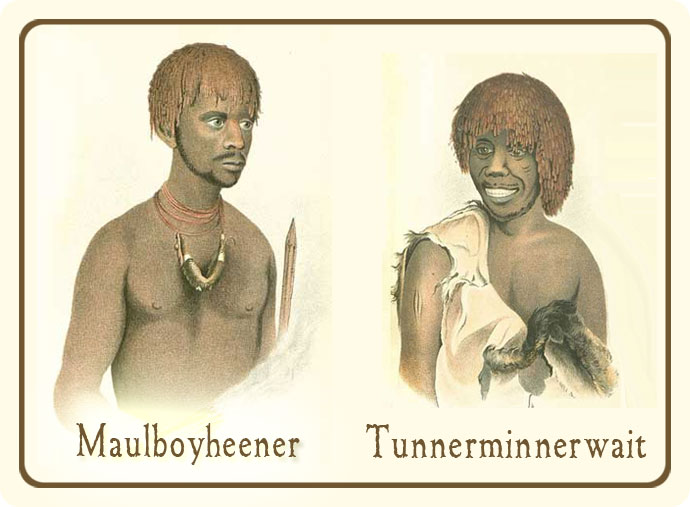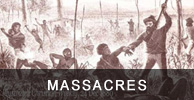Warriors in a forgotten war: Tunnerminnerwait and Maulboyheneer

AUDIO: Dr Clare Land provides a clearer and more comprehensive account of the Freedom Fighters from Tasmania that were hung in Victoria in 1842. ABC Radio National Interview.
'Hindsight' ABC Radio National Sunday 16 March 2014
The colony of Port Phillip was just eight years old when it held its first execution. The first people hanged in 1842 were two Aboriginal men from Tasmania. How did they come to be on the mainland?
The story of Tunnerminnerwait and Maulboyheneer is shocking, exciting, tragic and moving. Their tumultuous and short lives tell us so much about frontier conflict and the early colonial history of Tasmania and Victoria.
The two men were among a larger group of people, including Truganini, who were brought to the mainland by George Augustus Robinson, to act as intermediaries.
Six months into their travels through country Victoria with Robinson, they spectacularly abandoned life with the whites and went on a six week ‘crime spree’. Eventually caught and charged with murder of two seal hunters, the women were sent back to Tasmania but the two men were put to death in a brutally botched execution.
They are remembered every year on the anniversary of their death by local Aboriginal people, and Melbourne Council has unanimously agreed to create a memorial to their lives.

Tunnerminnerwait and Maulboyheneer heading for the gallows
'The first execution' Painted in 1875 by WFE Liardet. La Trobe Picture Collection, State Library of Victoria
Further Information
Playwright John Harding on his new play about the two men
Dr Clare Land's report
Radio Program Credits
Interviewee: Dr Clare Land
Producer: Lorena Allam
Sound Engineer
Louis Mitchell
 Dr Clare Land
Dr Clare LandClare has a PhD from Deakin University. Her thesis, entitled ‘The politics of solidarity with Indigenous struggles in southeast Australia’, was awarded the 2013 Isi Leibler Prize. She did honours in Koori and non-Koori history at the University of Melbourne, where she also worked for the Australian Women’s Archives Project.
City of Melbourne
Snapshot about Tunnerminnerwait and Maulboyheenner
![]() Historical account of Tunnerminnerwait and Maulboyheenner
Historical account of Tunnerminnerwait and Maulboyheenner
![]() Different forms of monuments
Different forms of monuments
Snapshot about Tunnerminnerwait and Maulboyheenner
Many of us are familiar with the story of Ned Kelly, but far few have heard of Tunnerminnerwait and Maulboyheenner, who are incredibly significant figures in Melbourne’s early history.
Tunnerminnerwait and Maulboyheenner’s story reveals key aspects of Aboriginal history in Melbourne and beyond. These men were born in Tasmania and brought to Melbourne by George Augustus Robinson, ‘Protector of Aborigines’ to Melbourne in 1839. In 1842, they became the first people to be hanged in Melbourne after they were convicted for the murder of two whale-hunters in the Western Port area. Their execution was the biggest story of the day in the newspapers.
Their execution took place before the existence of Old Melbourne Gaol on Russell Street, which was being constructed at the time. Instead, they were publicly hanged on Franklin Street, behind the City Baths. They are now understood to be buried on the site of the Queen Victoria Market.
Their stories touch on the history of crime and publishment in early Melbourne; the establishment of Melbourne in its wider context of conflict over land, important legal questions debated at the time, the treatment of Aboriginal people in Tasmania, and the any historical and community links between Port Phillip and Van Diemen’s Land (Tasmania).
Their stories are central to an understanding of Melbourne’s past, present and future.
Historical account of Tunnerminnerwait and Maulboyheenner
In 2012-13 a City of Melbourne research project began to investigate the potential for memorialisation of these two Aboriginal men. This came as the result of City of Melbourne’s commitment to this action in its Indigenous Heritage Action Plan.
The outcome of this research project is a booklet about Tunnerminnerwait and Maulboyheenner’s background and importance to Melbourne’s past and present, called 'Tunnerminnerwait and Maulboyheenner: The involvement of Aboriginal people from Tasmania in key events of early Melbourne'. Read the booklet:
- Tunnerminnerwait and Maulboyheenner (PDF, 5.4MB)
- Tunnerminnerwait and Maulboyheenner (RTF – text only, 365kb)
You can also read a discussion of appropriate forms of monuments or public commemorations of histories like this one that are complex, in Forms for Monuments to Complex Histories (PDF, 2.7MB).
Source: City of Melbourne
 Public monument proposal - 'The Freedom Fighters'
Public monument proposal - 'The Freedom Fighters'
 The Freedom Fighters - Lest We Forget
The Freedom Fighters - Lest We Forget
 'The Forgotten War' - slaughter on stolen lands
'The Forgotten War' - slaughter on stolen lands






